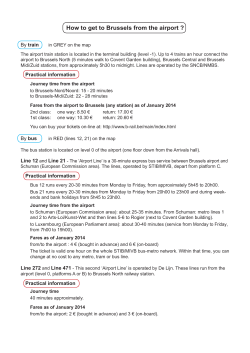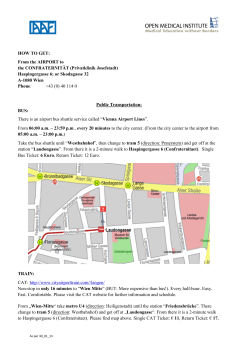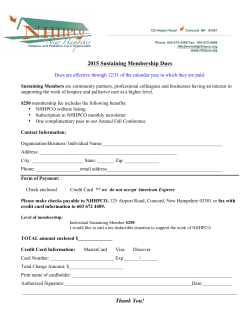
ARFF Solutions www.arffsolutions.com DM Pierce A.F.O.
Asiana 214 Accident - NTSB Findings & Recommendations for SFO ARFF http://www.youtube.com/watch?v=eXCwI6a1D qI Aircraft rescue and firefighting (ARFF) training for officers placed in command of an aircraft accident. The arriving incident commander placed an officer in charge of the fire attack who had not received ARFF training, and this individual made decisions that reflected his lack of ARFF training. Although no additional injuries or loss of life could be attributed to the fire attack supervisor’s lack of ARFF training, it demonstrates the potential strategic and tactical challenges associated with having non-ARFF trained personnel in positions of command at an airplane accident. Guidance on when to pierce the fuselage of a burning airplane with a skin-piercing nozzle. The airport’s fire department had two vehicles equipped with high-reach extendable turrets (HRETs) that were not used to the best of their capabilities in the initial attack. This was partially the result of departmental guidance that discouraged penetration of the fuselage using the skin-piercing nozzles on the HRETs until all of the occupants were known to have evacuated the airplane. Current FAA guidance provides information on how to pierce but does not include any guidance on when to pierce. Integration of the medical supply buses at SFO into the airport’s preparation drills. Although the airport’s emergency procedures manual called for airport operations personnel to deliver the airport’s two emergency medical buses to the accident site, neither of the medical buses arrived. Further, the monthly emergency drills conducted by the airport did not include deployment of the buses either as a matter of routine or as part of the unique scenario being evaluated. This lack of integration of the medical buses into the airport’s preparation drills likely played a part in their lack of use in the initial response to the accident. Guidance or protocols for ensuring the safety of passengers and crew at risk of being struck or rolled over by a vehicle during ARFF operations. In this case, only one passenger was at significant risk for a vehicle strike due to her close proximity to the burning airplane; however, there are other accident scenarios in which many injured or deceased persons could be located near an accident airplane. There is currently no guidance or any recommended protocols for ensuring the safety of passengers and crew at risk of being struck or rolled over by a vehicle during ARFF operations. Requirements for ARFF staffing. Seven ARFF vehicles and 23 ARFF personnel from SFO’s fire department were involved in the initial response to the accident. This equipment level exceeded the FAA-required minimum of three vehicles, and there is currently no FAA-required minimum staffing level. Because of the amount of available ARFF vehicles and personnel, the airport firefighters were able to perform exterior firefighting and send firefighters into the airplane who rescued five passengers who were unable to selfevacuate amid rapidly deteriorating cabin conditions. Due to the lack of an FAA-required minimum staffing level, passengers involved in an aviation accident at a smaller airport may not be afforded the same level of protection that the passengers of flight 214 had. 23) Clearer guidance is needed to resolve the concern among airport fire departments and individual firefighters that the potential risk of injuring airplane occupants while piercing aircraft structure with a skin-penetrating nozzle outweighs the potential benefit of an early and aggressive interior attack using this tool. - NFPA 402, 11.4.2, Figure A.11.4.5 - NFPA 414, 4.19.6.11, 4.19.6.12 (Amend?) 24) Medical buses were not effectively integrated into San Francisco International Airport’s monthly preparation drills, which played a part in their lack of use in the initial response to the accident and delayed the arrival of backboards to treat seriously injured passengers. - NFPA 424, 13.3.3 25) Guidance on task prioritization for responding ARFF personnel, that addresses the presence of seriously injured or deceased persons in the immediate vicinity of an accident airplane, is needed to minimize the risk of these persons being struck or rolled over by vehicles during emergency response operations. - NFPA 402, 7.3.4 - NFPA 424, 14.1, 14.2.3, 14.2.4 26) The overall triage process in this mass casualty incident was effective with the exception of the failure of responders to verify their visual assessments of the condition of passenger 41E. - NFPA 424, 13.6.3 27) The San Francisco Fire Department’s aircraft rescue and firefighting staffing level was instrumental in the department’s ability to conduct a successful interior fire attack and successfully rescue five passengers who were unable to selfevacuate amid rapidly deteriorating cabin conditions. -NFPA 403, 8.1.2.1 28) Although no additional injuries or loss of life were attributed to the fire attack supervisor’s lack of aircraft rescue and firefighting (ARFF) knowledge and training, the decisions and assumptions he made demonstrate the potential strategic and tactical challenges associated with having non-ARFF trained personnel in positions of command at an airplane accident. - NFPA 403, 8.1.4, (Ref. to NFPA 1003) - NFPA 403, 8.1.4.1 (Ref. to NFPA 405) 29) Although some of the communications difficulties encountered during the emergency response, including the lack of radio interoperability, have been remedied, others, such as the breakdown in communications between the airport and city dispatch centers, should be addressed. -NFPA 403, 7.1, -NFPA 424, 11.1 30) The Alert 3 section of the San Francisco International Airport’s emergency procedures manual was not sufficiently robust to anticipate and prevent the problems that occurred in the accident response. - NFPA 424, 12.2 Work with the Aircraft Rescue and Firefighting Working Group and equipment manufacturers to develop and distribute more specific policies and guidance about when, how, and where to use the high-reach extendable turret’s unique capabilities. Once the minimum staffing level has been developed by the Aircraft Fire and Rescue (ARFF) Working Group, as requested in Safety Recommendation [25], amend 14 Code of Federal Regulations 139.319(j) to require a minimum ARFF staffing level that would allow exterior firefighting and rapid entry into an airplane to perform interior firefighting and rescue of passengers and crewmembers. Work with the Aircraft Rescue and Firefighting (ARFF) Working Group to develop policy guidance and training materials to ensure that all airport and mutual aid firefighting officers placed in command at the scene of an aircraft accident have at least a minimum level of ARFF training. Issue a CertAlert to all Part 139 airports to distribute the information contained in the Federal Aviation Administration’s (FAA) legal interpretation of 14 CFR 139.319 that requires all personnel assigned to aircraft rescue and firefighting duties to meet the initial and recurrent training and live-fire drill requirements and clarify how the FAA will enforce this regulation. Conduct a special inspection of San Francisco International Airport’s emergency procedures manual and work closely with the airport to ensure that the airport meets its obligations under Part 139.325. No references to any NFPA documents! 11:28:00 11:31:11 11:32:10 11:37:00 11:38.37 11:42:00 11:47:00 11:48:34 11:49:41 Alert III (10s after impact) First ARFF unit on scene (3:11s) Full self-evacuation completed Passenger 41E body sighted Interior attack with handline (10:37s) Mutual-aid resources on scene (24m) Last passenger rescued (5 total) Passenger 41E struck by first ARFF vehicle HRET deployed (21:41s) 11:51:30 11:52:42 11:55:00 12:01:11 12:06:29 12:18:30 13:01:00 17:58:00 Incident Commander on scene (23m) Pierced aircraft above 2L door (3:01s) Piercing tip withdrawn (50s -broken) Passenger 41E struck again by second ARFF vehicle Passenger 41E body covered Fire brought under control (50:30s) Last non-ambulatory transported (1:33:00) Last ambulatory transported Thank-you!
© Copyright 2025









